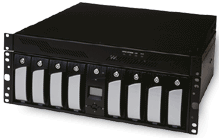| |

- Very Affordable & Scalable NAS solution - from few hundred Gigabytes to multiple Terabytes.
- Very Flexible - Used in connection with JStor RAID it gives you the flexibility to start with a direct-attached RAID array, then Upgrade to a NAS device. Or to "detach" some JStor RAID arrays from the JStor NAS to be used independently as server attached storage.
- Can attach multiple JStor RAID arrays to JStor NAS engine.
- Works with JStor IDE/S-ATA units as well as JStor SCSI units.
- Provides Hardware NAS engine and Hardware RAID array for blazingly fast performance.
The JStor NAS Storage Appliance provides an affordable, scalable storage option for your network. This high-performance, LAN-attached device is designed to provide shared storage to both clients and servers in Windows, UNIX, Apple Macintosh or mixed environments. Engineered to meet stringent demands for continuous availability, JStor NAS features a brand-new 64-bit RISC processor for blazingly fast parity calculation and I/O operations, completely cableless backplane-based design, and storage capacities reaching 14TB starting at a 4U enclosure.
Low service and integration costs are assured by the JStor cableless design, two redundant hot-swappable power supplies, turbo cooling fans, and embedded hardware RAID controller. Three year warranty comes standard with every NAS and covers all components.
JStor NAS Storage Appliance delivers multi-protocol support (Windows CFS, NFS, HTTP, FTP and Novell IPX)that eliminates the need to have separate servers for each supported protocol, further enhancing their ability to consolidate storage from multiple general-purpose servers.
JStor NAS is designed to be easy to use and install and includes robust capabilities designed to improve storage reliability and availability helping to ensure your business applications are available when you need them.
|

Drive capacities of 9.1GB (7,200 / 10,000 rpm), 18GB (7,200 / 10,000 / 15,000 rpm), 36GB (7,200 / 10,000 / 15,000 rpm), 73GB (10,000 rpm), and 180GB (7,200 rpm) are available.
Maximum capacity 1440GB when using 180GB drives.
Scaleable to 5.7TB
|

General
|
| |
RAID Architecture
|
|
64-bit RISC 100MHz CPU with 100MHz memory bus
Up to 800 Mbytes/sec bandwidth
|
| |
NAS Engine Architecture
|
|
64-bit CISC 500MHz CPU with 100MHz memory bus
|
| |
Peripheral Bus Interface
|
|
Two, 160 MB/sec. Ultra3 LVD (Low Voltage Differential) SCSI
|
| |
Disk Bus Interface
|
|
Two, 160 MB/sec. Ultra3 LVD (Low Voltage Differential) SCSI
|
| |
Command Queuing
|
|
254 commands (host and disk SCSI channels)
|
| |
Cache
|
|
Up to 512 MB NAS Engine
Up to 512 MB RAID Subsystem
|
| |
Network Interface
|
|
Ethernet 10/100Base-T
Optional 1000Base-T Gigabit Ethernet (copper or fiber channel)
|
| |
Network Protocols Supported
|
|
Windows: CIFS/SMB (TCP/IP), WINS, DHCP
UNIX: NFS, TCP, ARP, RARP, DHCP, FTP, BOOTP
Novell: IPX/SPX, NDS
Macintosh: AFP, AFP over TCP/IP
|
| |
| |
Environmental
|
| |
Temperature
|
|
50°F to 104°F operating, -40°F to +140°F non-operating 10°C to 40°C operating, -40°C to +60°C non-operating
|
| |
Relative Humidity
|
|
10% to 85% non-condensing (operating), 5% to 90% non-condensing (non-operating)
|
| |
Certifications
|
|
FCC, CE, TUV, and UL/CSA
|
| |
| |
Physical
|
| |
Size/Weight
|
|
19" wide, 18" deep, 7" (4U) high, 60 lb. / 27 kg. (without disk drives)
|
| |
I/O Connectors
|
|
NAS Engine: RJ-45 Network port
RAID Subsystem: Four standard 68-pin SCSI, two 9-pin DB9 type RS-232 serial
terminal port and fax / pager port
|
| |
Power Required
|
|
110 or 220 VAC, ±20% @ 3 amps peak; 47 to 63 Hz. autosensing
|
|
|

JStor NAS Engine

JStor NAS - 8 bay rackmount

|
Backup/Restore support via NDMP.
Support for Share level security, File level security, and User ID security for NFS.
Up to eight half-height SCA Wide/Ultra3/LVD 3.5" SCSI disk drives.
Hardware RAID controller provides RAID 0, 0+1, 1, 3, and 5, Global Hot
Spare Disk, Auto Rebuild, and up to 512 MB of SO-DIMM SDRAM-based data
cache.
Intelligent SCSI backplane design (uses no cables) allows "hot swapping" of
disk canisters, power supplies, and fans for increased reliability, lower
cost, and ease of maintenance.
In-band SCSI monitoring and fault notification to fax / pager or
e-mail.
Completely user configurable via a web browser.
|
|